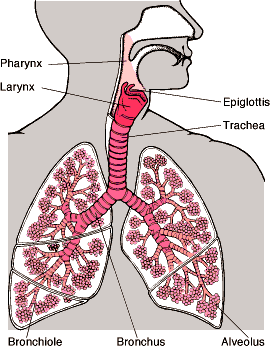

Introduction
Bronchitis is a state of increased mucus production, with or without adequate mucociliary transport, that requires cough for clearance of airway secretions. Airways respond to injury or irritation by increased mucus secretion. If normal mucociliary clearance is unable to handle the increased mucous, we cough. But if we are unable to clear mucous by normal mucociliary clearance and coughing, we can develop chronic airway obstruction with stasis of secretions and recurrent or persistent infection, leading to airway destruction and remodeling (bronchiectasis).
Chronic bronchitis in adults is defined as a productive cough daily for 3 months/year for 2 consecutive years. Chronic bronchitis in children is defined as a productive cough of greater than 2 months duration or recurrent episodes of productive cough greater than 4 times/year
Among the bugs commonly identified with chronic bronchitis in adults are nontypeable Hemophilus influenzae, Hemophilus para influenzae, Moraxella catarrhalis, Strep. Pneumoniae and Staphylococcus aureus.
Unlike in Anchorage and other parts of the US, chronic respiratory symptoms are not uncommon among Alaska Native children in the Yukon-Kuskokwim region. One study found that 40% had either asthma (13%), asthma with chronic productive cough (7%) or chronic productive cough without asthma (19%).
A number of conditions can trigger chronic productive cough and it is important to screen kids with chronic cough for these conditions. The list includes:
--Chronic bronchitis
--Asthma
--Complications of medical treatment with subsequent ineffective cough, for example, after tracheoesophageal fistula repair, cardiac surgery, chemotherapy
--Cystic fibrosis
--Aspiration syndrome: Gastroesophageal reflux with aspiration can irritate airways and cause increased mucus production
--Chronic foreign bodies
--Tuberculosis
--Mucociliary disorders with impaired mucous clearance
--Immune deficiencies
--Ineffective cough associated with conditions like tracheostomies, airway obstruction, tracheobronchomalacia, or neuromuscular disorders
--Environmental triggers, like
smoke, wood products, paint odors, fumes, cosmetics, and food
smells.
Distinguishing chronic bronchitis from asthma. In comparison to
kids with asthma, Seear et al. found that kids with chronic bronchitis:
--Develop symptoms at a younger age (0.6 years vs. 2.5 yrs
--Are more likely to have chronic otitis media (41% vs. 2%)
--Are more likely to be exposed to maternal smoking (74% vs 27%).
--Are less likely to have eczema (9% vs. 32%)
--Are less likely to have a family history of asthma (15% vs. 62%)
(Source: Seear M, Wensley D. Chronic cough and wheeze in children: do they all have asthma? Eur Respir J. 1997 Feb;10(2):342-5)
But kids with chronic bronchitis may also have concurrent asthma. And kids with bronchiectasis or cystic fibrosis may also improve with inhaled bronchodilators.
How to treat kids with idiopathic bronchiectasis?
1. Reduce secretion production:
Reduce irritant exposure
Reduce aspiration events
Reduce GER
2. Reduce infection exposure:
Dental hygiene
Antibiotics for upper and lower airway exacerbations
3. Promote secretion clearance with chest physiotherapy:
4. Reduce airway obstruction with bronchodilators and inhaled steroids
5. Prevent infection with immunizations, including influenza vaccine, 7 and 23 valent pneumococcal vaccines, and standard vaccines, and Synagis (palivizumab) if appropriate.
Disclaimer: This information is not intended be a substitute for professional medical advice. It is provided for educational purposes only. You assume full responsibility for how you choose to use this information.